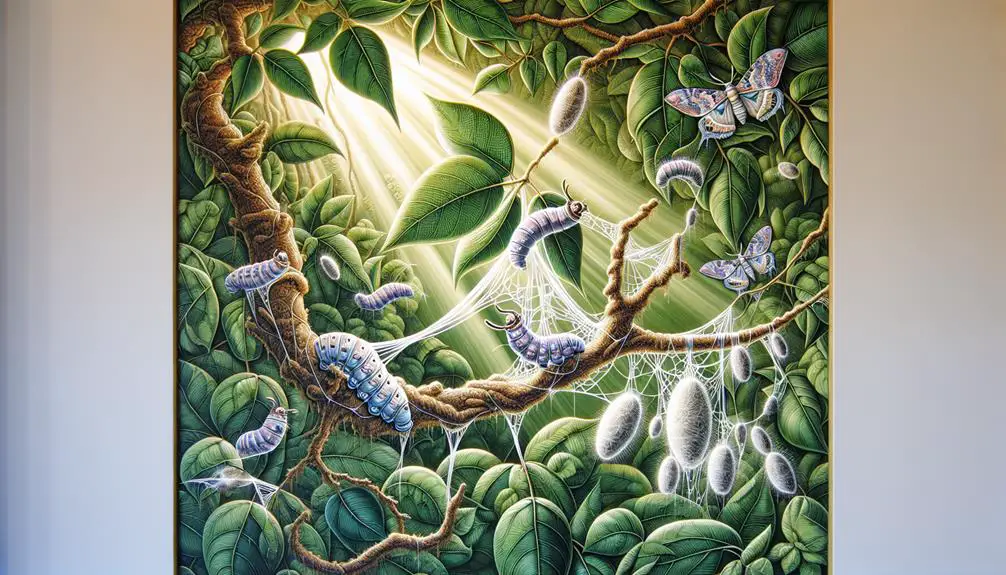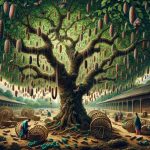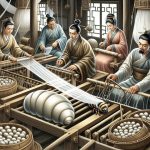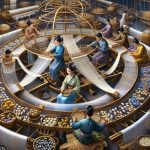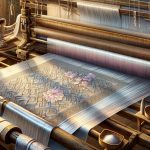Silk's origin traces back to ancient China, where sericulture using the Bombyx mori species began. The process involved feeding silkworms mulberry leaves to produce cocoons up to a kilometer long. Lady Hsi-Ling-Shih's contributions in 3000 BC were pivotal. Silk symbolized status and wealth, becoming a cornerstone of Chinese culture and economy. Through the centuries, selective breeding improved silk quality, leading to the luxurious fabric that is familiar today. The journey of silk through trade routes and the economic significance it holds globally showcases the rich history and value of this exquisite material.
Table of Contents
Key Takeaways
- Silk originates from the cocoons of Bombyx mori silkworms.
- Bombyx mori feed on mulberry leaves to produce silk.
- Sericulture, the process of extracting silk threads, is the source of silk.
- Lady Hsi-Ling-Shih introduced sericulture in ancient China.
- Silk production in China dates back to around 3000 BC.
Ancient Chinese Silk Production
Ancient Chinese silk production traces back to around 3000 BC, as per Chinese legend, marking the genesis of this luxurious fabric's creation. The Chinese are credited with the discovery of silk, and the industry quickly became an essential part of their culture and economy.
Silk production in China involved the domestication of silkworms, primarily the Bombyx mori species, which fed on the leaves of mulberry trees. These silkworms would then form cocoons made of a single thread of raw silk that could stretch up to a kilometer in length. The process of extracting these delicate threads from the cocoons, known as sericulture, required skill and finesse.
The Chinese mastered the art of silk production, keeping it a closely guarded secret for centuries. This early form of the silk industry laid the foundation for the development of silk trade routes and the establishment of silk as a symbol of luxury and prestige.
Lady Hsi-Ling-Shihs Contribution
Lady Hsi-Ling-Shih's renowned contribution to silk production in ancient China is a pivotal part of the fabric's rich history, dating back to around 3000 BC. According to Chinese legend, she played an essential role in introducing sericulture, which eventually led to the development of specialized silk-producing moths.
Initially, silk was a luxury reserved for the Chinese emperor and high dignitaries, symbolizing status and wealth. Over time, silk became a cornerstone of the Chinese economy, driving trade and cultural exchange both within China and beyond its borders.
Lady Hsi-Ling-Shih's early involvement in silk production set the stage for the flourishing silk industry that followed, shaping not only the economic landscape but also the cultural tapestry of ancient China. Her legacy continues to be revered, marking her as a pioneer in the history of silk production and a key figure in the evolution of this prized fabric.
Evolution of Silk Production Techniques
When it comes to silk production techniques, the evolution of weaving methods, harvesting processes, and dyeing techniques has been remarkable.
Innovations in looms and weaving practices revolutionized the intricate designs of silk brocades and damasks. Additionally, advancements in silk harvesting and dyeing methods further enhanced the quality and efficiency of silk production over time.
Silk Weaving Methods
With the advancement of technology and innovative looms, silk weaving methods have evolved greatly over the centuries, revolutionizing silk production techniques globally.
Chinese drawlooms and pedal looms were pioneers in intricate silk weaving, enabling detailed designs and enhancing worker mobility. The production of silk brocades and damasks using innovative looms from the 2nd century BC highlighted silk's adaptability in design.
Byzantine silk set a high standard with its quality weaving and intricate decorations, influencing silk production in Europe. Over time, improved technology led to greater efficiency in silk production, facilitating the global popularity of silk textiles.
Water-powered mills played a vital role in advancing silk production techniques, boosting productivity and quality in the industry.
Silk Harvesting Process
As silk weaving methods advanced through the centuries, the evolution of silk production techniques saw significant progress in the silk harvesting process, known as sericulture. Sericulture involves the careful maintenance of silkworm eggs, feeding them mulberry leaves, and collecting their cocoons. Discovering sericulture techniques around 5,000 years ago in China marked the beginning of this intricate process.
Each silk cocoon can yield about 900 meters of silk thread, showcasing the efficiency of silk production. Silk's unique triangular cross-section enhances its dyeing properties, allowing for intricate designs and patterns. The evolution of silk production techniques has refined sericulture practices, ensuring high-quality silk output. These advancements have revolutionized the silk harvesting process, enabling the creation of exquisite and durable silk products.
Silk Dyeing Techniques
Silk dyeing techniques have evolved remarkably over centuries, allowing for the creation of intricate patterns and designs on silk fabrics.
- Traditional Chinese silk dyeing methods involved using natural dyes derived from plants, minerals, and insects.
- Intricate silk dyeing techniques like tie-dyeing, batik, and resist dyeing were developed in China.
- Chinese artisans mastered the art of silk painting, creating vibrant and long-lasting colors on silk.
- Silk dyeing techniques in China were closely guarded secrets, passed down through generations.
- The use of natural dyes enabled the production of a wide range of colors, enhancing the beauty and quality of silk fabrics.
Development of Bombyx Mori
In the fascinating world of silk production, the development of Bombyx Mori stands as a demonstration of ancient ingenuity and craftsmanship. Bombyx Mori, the silkworm species domesticated in ancient China, is renowned for producing high-quality silk fibers. These silkworms have a life cycle that includes stages like egg, larva, pupa, and adult, with silk production mainly taking place during the larval stage.
To nurture these remarkable creatures, they're fed mulberry leaves, which provide essential nutrients for their growth and silk production. During the larval stage, Bombyx Mori spins its cocoon, a process essential for harvesting silk fibers. The selective breeding and care given to Bombyx Mori over thousands of years have resulted in a species uniquely suited for silk production, making it a cornerstone of the silk industry.
The intricate relationship between Bombyx Mori and silk production showcases the deep understanding ancient civilizations had of nature's gifts.
Sericulture in Early China
So, let's talk about how ancient China really set the stage for all things silk-related.
The Chinese were pretty sneaky about keeping their silk-making techniques under wraps, maintaining a tight grip on their silk monopoly.
Plus, they made sure only the big shots like the emperor got to flaunt those luxurious silk threads.
Ancient Chinese Silk Production
Ancient Chinese silk production, dating back thousands of years, was a closely guarded art that flourished under the reign of Empress Hsi-Ling-Shih.
- Sericulture, a process dating back 6000-7000 years in ancient China
- Reserved for the elite, symbolizing luxury and wealth
- Evolved during the Tang Dynasty, boosting the Chinese economy
- Secrets closely guarded, leading to specialized silk-producing moths
Silk, initially a luxury material for the emperor and dignitaries, became a cornerstone of the Chinese economy. The meticulous care in producing silk and the exclusivity surrounding its creation added to its allure, shaping the economic landscape and defining luxury in ancient China.
Silk Secrets Revealed
Lady Hsi-Ling-Shih's introduction of silk production around 3000 BC marked the beginning of a long history of closely guarded sericulture practices in ancient China. The Chinese mastered the art of silk production, turning it into a coveted secret that fueled their silk monopoly.
Through meticulous processes like caring for silkworm eggs, feeding, cocoon spinning, and silk extraction, they created a thriving silk economy. Archaeological evidence suggests that Chinese sericulture dates back 6000-7000 years.
Silk quickly became a symbol of luxury and power, initially reserved for the emperor and elite dignitaries. The intricate techniques of silk production were carefully passed down through generations, ensuring China's dominance in the silk industry and the mystique surrounding its secrets.
Spread of Silk Through Trade Routes
Silk's journey across the ancient trade routes began in China around 3000 BC and swiftly extended its reach to Korea, India, and beyond. The spread of silk was a fascinating process influenced by various factors:
- Chinese silk monopoly: Chinese princess smuggled silkworm eggs to Khotan (Hetian) in AD 440, breaking China's silk monopoly.
- Global reach of silk: Evidence of silk trade found in an Egyptian mummy dating back to 1070 BC, showcasing its early global reach.
- Silk ambassadors: Chinese Emperor Han Wu Di's ambassadors carried silks west in the 2nd century BC, aiding in silk's spread.
- Nestorian monks: Nestorian monks brought silkworm eggs to Byzantine Emperor Justinian around AD 550, influencing silk production in the West.
- Silk smuggling: Various instances of silk smuggling occurred throughout history, contributing to the widespread availability of this luxurious fabric.
The intricate network of silk trade routes and the involvement of key figures played pivotal roles in the dissemination of silk across continents, shaping its significance in global trade.
Silks Economic Significance
Silk has played an essential role in shaping economies throughout history, from the ancient Silk Trade Routes to modern-day market trends.
The production process of silk has supported millions of people globally, contributing to economic stability in various regions.
As a luxury fabric with unique properties, silk continues to hold high value in the global market, showcasing its enduring economic significance.
Silk Trade Routes
Having originated in China around 3000 BC, the global spread of silk trade routes through the Silk Road had a significant impact on economies and cultural exchange.
The Silk Road was a pivotal pathway for the trade of this valuable commodity, connecting China to the West and influencing ancient trade routes. Chinese silk, known for its quality, became highly coveted in places like Rome, shaping interactions and economies.
The Silk Road not only facilitated the flow of goods but also served as a bridge for cultural exchange, where ideas and traditions were shared. This intricate network of trade routes played a notable role in the economic significance of silk, leaving a lasting mark on history.
Silk Production Process
With each unraveling of a silkworm cocoon, the intricate process of extracting silk fibers unfolds, supporting millions globally and weaving together an essential economic fabric.
Silk production, mainly sourced from the Bombyx mori species, involves carefully extracting silk fibers from cocoons. A single silkworm cocoon can yield around 900 meters of silk thread, showcasing the efficiency of this ancient practice.
Not only is silk production a significant economic activity, providing livelihoods for over 34 million people worldwide, but it also holds immense cultural significance. The weaving skills associated with silk production have been passed down through generations, adding to the rich tapestry of traditions surrounding this exquisite material.
Silk Market Trends
Amidst global economic shifts, the allure of silk as a luxury fabric continues to shape market trends in a substantial manner. China maintains its dominance in silk production, holding over two-thirds of the global market share. The silk industry plays a crucial role in supporting around 34 million people worldwide, contributing notably to economic stability.
Major silk-producing countries like China, India, Brazil, North Korea, Thailand, and Vietnam contribute to the thriving silk trade. The traditional craftsmanship of silk weaving skills, passed down through generations, adds a unique value to the industry.
The continuous demand for silk fabric, characterized by its luxury and distinct properties, ensures the market's stability and growth.
Mulberry Silk Cultivation
When delving into the world of silk production, mulberry silk cultivation stands out as the predominant method globally. Mulberry silk, derived from silkworms that feed exclusively on mulberry leaves, is renowned for its exceptional quality, smooth texture, and luxurious feel. The majority of silk production worldwide originates from mulberry silk cultivation due to its superior attributes such as durability, sheen, and excellent dye-absorption properties.
Mulberry silk is highly favored for its strength and resilience, making it a popular choice for various silk products. Its natural sheen adds a touch of elegance, while its ability to absorb dyes results in vibrant and long-lasting colors. The cultivation process of mulberry silk involves meticulous care for the silkworms and the mulberry trees they feed on, ensuring the production of top-quality silk. This attention to detail contributes to the premium status of mulberry silk in the global silk market.
Silks Journey Along the Silk Road
Silk's journey along the Silk Road began as a closely guarded secret of sericulture in China around 3000 BC. The Silk Road played an important role in the spread of silk to various regions, including Korea, India, and beyond around 200 BC.
Evidence of silk trade can be traced back to 1070 BC, with silk discovered in an ancient Egyptian mummy. Chinese Emperor Han Wu Di's ambassadors further carried silk westward in the 2nd century BC, contributing to the globalization of this luxurious fabric.
Globalization of Sericulture
As sericulture expanded beyond China along the Silk Road, the global reach of silk production witnessed significant growth over the centuries. Chinese silk production spread to Korea around 200 BC and later reached India by AD 300. Evidence of silk trade was found in an Egyptian mummy dating back to 1070 BC, showcasing the early globalization of sericulture.
Nestorian monks played a pivotal role in this expansion by bringing silkworm eggs to the Byzantine Empire around AD 550, further spreading the knowledge of silk production. By the 6th century, Persians had mastered silk weaving techniques, contributing to the globalization of sericulture.
In the 13th century, Italy joined the silk production industry, with skilled weavers from Constantinople enhancing their capabilities. This interconnected network of silk trade and sericulture activities exemplifies the profound impact of globalization on the spread and evolution of silk production techniques across different regions.
Modern Silk Industry Perspectives
In today's modern silk industry, various countries, including China, Japan, South Korea, and Thailand, play significant roles in the production and innovation of this luxurious material.
- China: Largest producer of raw silk, holding over two-thirds of the global market share.
- Japan, South Korea, and Thailand: Major players in the modern silk industry.
- Technological advancements: Evolution in production methods leading to increased efficiency.
- Competition: Despite challenges from man-made fibers, global silk production has doubled in the last 30 years.
- Luxury material: Silk remains a significant luxury material, with China at the forefront of silk production.
The modern silk industry continues to thrive with advancements in technology, making silk production more efficient and sustainable. While competition from synthetic fibers exists, the allure of silk as a luxury material endures, driving innovation and growth in the industry. China's dominance in raw silk production sets the tone for the global market, with other countries like Japan, South Korea, and Thailand also making substantial contributions to the modern silk industry.
Frequently Asked Questions
Where Did Silk Originally Come From?
Silk, originating from China around 3000 BC, was discovered by Empress Hsi-Ling-Shih. It quickly became an essential economic asset, initially reserved for the emperor. Over time, silk production evolved into a specialized practice, influencing trade and culture.
What Is the Primary Source of Silk?
The primary source of silk is the cocoon of the silk moth, Bombyx mori. Silkworms feed on mulberry leaves, and unraveling their cocoons produces silk threads. Each cocoon yields about 900 meters of silk.
What Is the Main Source of Silk?
The main source of silk is the Bombyx mori silkworm, which produces top-quality silk. These silkworms feed on mulberry leaves, resulting in fine, strong, and lustrous fibers. Sericulture revolves around cultivating these silkworms, bred for centuries for superior silk.
How Is Original Silk Made?
I'll explain how original silk is made. Silkworms spin cocoons with silk threads to protect themselves. The threads are unraveled and woven into fabric. This centuries-old process involves carefully cultivating silkworms and harvesting their silk.
- How Does Ring Spun Cotton Affect Garment Fit and Shape Retention? - August 13, 2024
- What Are the Challenges in Producing Ring Spun Cotton? - August 13, 2024
- Is Ring Spun Cotton Suitable for Plus-Size Clothing? - August 13, 2024

